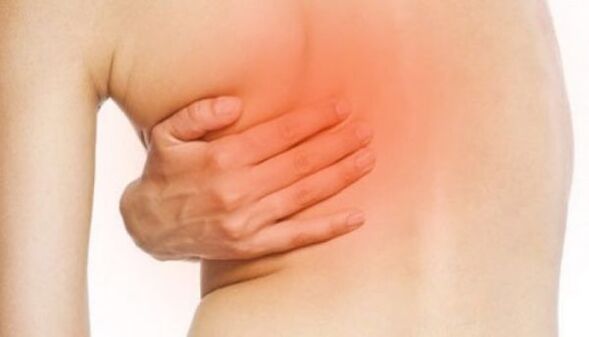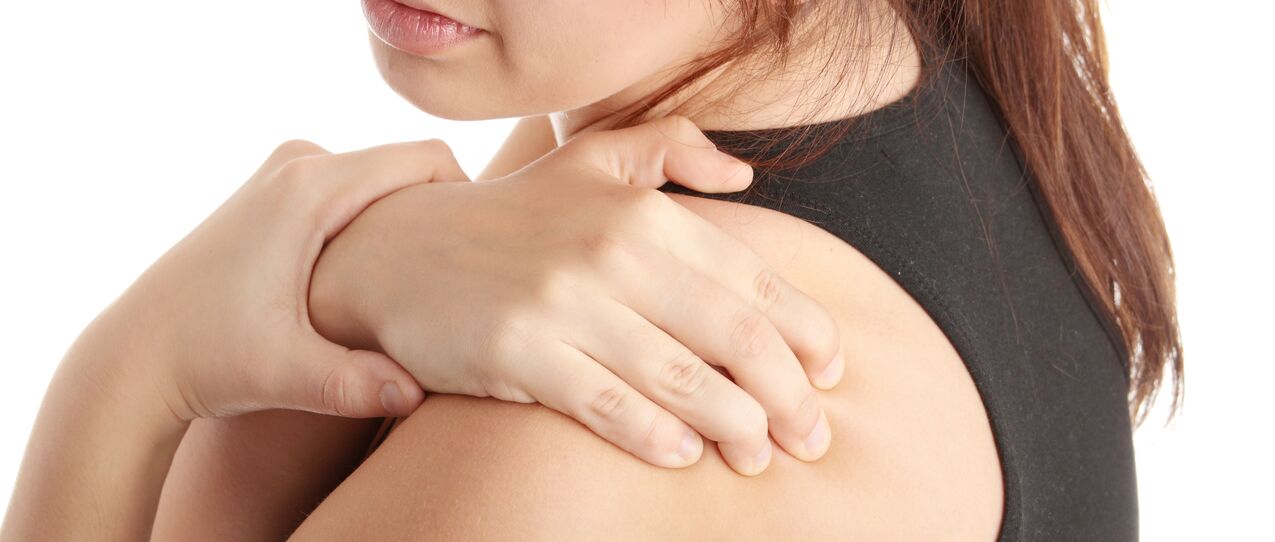Painful sensations under the scapula - this symptom can be experienced by adults suffering from diseases of the musculoskeletal system or pathology of internal organs, and by children who simply did not calculate physical activity or exerciseare held upright in a draft.
Self-administration of analgesics for subscapular pain is absolutely unacceptable: such painful sensations can be a sign of life-threatening conditions.
At the same time, attention, and often emergency medical attention, not only deserves a sharp pain, but also a dull ache under the left shoulder blade.
The nature of the pain and the symptoms that accompany it help suggest a particular disease. However, only a qualified doctor, based on the patient's complaints, will be able to understand the damage to which the organ caused pain, prescribe the necessary diagnostic examination and, if necessary, provide emergency assistance. .
Causes of pain under the left shoulder blade in the back of the back

The proximity of the lungs, heart and spine, as well as a large network of nerve fibers, expands the list of possible causes of subscapular pain. In this case, each disease is characterized by other specific signs, and the nature and duration of painful sensations also change.
Pathology of the musculoskeletal system and nerves
Diseases of the spine and muscle structure of the back are a common cause of left subscapular pain. Pain in these diseases is often one-sided.
- Osteochondrosis - the formation of osteophytes in the thoracic or cervical spine causes pulling pain to the left or right, starting from the neck and upper back, and ending with irradiation in the arm. The pain does not go away with rest, often prolonged but bearable.
Important! The causes of pain under the left shoulder blade of the back of the back, which radiate into the arm and are of a pressing nature - osteochondrosis and angina pectoris - have a peculiarity. With angina, the pain lasts up to 30 minutes, with osteochondrosis - several days. In addition, an angina attack is stopped by nitroglycerin or other heart medications.
- Intercostal neuralgia - accompanied by severe pain spreading throughout the intercostal space and made worse by breathing, spinning, sneezing / coughing. Often with neuralgia, the sensitivity of the skin causing the pain also changes. Neuralgia causes paresthesia in the form of goose bumps, while numb pain under the left scapula often occurs with myocardial infarction, angina pectoris.
- Scapular Rib Syndrome - is a "reward" for hard physical work or activities associated with a long stay in a position (office workers). People complain of dull, non-intense pain localized between the neck and shoulder, radiating under the scapula.
Sometimes subscapular pain is provoked by myositis (at the same time there is stiffness of movements and tension of certain muscle groups), injuries of the scapula (sharp pain, always preceded by a fall, stroke, etc. ) or oncology (pain may occur periodically, not severe). Tuberculosis of the bones, namely the defeat of the scapula, can not be excluded.
Diseases of the heart and blood vessels
Cardiac pathology is one of the most dangerous, which can be diagnosed when a patient complains of subscapular pain. In this case, the pain in heart disease does not always start on the front surface of the chest (behind or to the left of it). The cause of pain under the left shoulder blade, in the region of the heart may be:
- Angina pectoris - the pressing pain behind the breastbone extends under the left scapula and collarbone, into the jaw and arm. The intensity of the pain is reduced at rest, but the change in body position does not provide relief. With scapulo-costal (vertebrogenic) syndrome, the situation with increased pain is radically opposite. Angina pectoris attack is alleviated by taking Nitroglycerin, with spinal pain, manual therapy is excellent.
- Myocardial infarction is a sharp, increasing pain of the heart with characteristic irradiation to the left (including under the scapula) that is not stopped by cardiac glycosides. The patient experiences intense fear, which is not the case with damage to the spine and nerve fibers. Immediate hospitalization required!
Important! Both for ischemic heart disease (angina pectoris, heart attack) and for cervical osteochondrosis, numbness of the tongue on the left is characteristic.
- Hypertensive crisis - often accompanied by pressing heart pain radiating to the left scapula. The cause of the pain is easily determined by measuring a / d.
- Pericarditis - with this disease the pain subsides at rest and when the trunk is tilted forward. The pain appears in the region of the heart anteriorly, radiates under the scapula, but not as intense as in acute myocardial ischemia (angina pectoris, heart attack).
- Detachment, aortic aneurysm is a dangerous condition characterized by a throbbing pain under the scapula. The rapid increase in pain requires an urgent call from the medical team.
Important! Often, a symptomatic picture similar to cardiac pathology is given by vegetative-vascular dystonia. At the same time, the demonstration of his serious condition is clearly faked (psychogenic factor), the patient is often nervous, trembles, has a fever and a feeling of lump in the throat.
Respiratory tract diseases
Pain under the left scapula can cause the following lung diseases:
- Pneumonia - gives pain only when the inflammatory focus is located near the pleural membrane. Painful sensations of low intensity occur periodically, have a point localization and intensify with breathing.
- Pleurisy - unlike pneumonia, the pain is sharp and throbbing. Its intensity depends on the depth of breathing.
Concomitant pulmonary symptoms accompanying pain when inhaling under the left scapula are shallow and rapid breathing, shortness of breath, fever. Hyperthermia can also occur with pericarditis. It is extremely rare that a slight increase in temperature occurs with severe neuralgia, myositis.
Important! Unlike heart disease, with pathology of the respiratory tract, the pain is accompanied by night sweats and coughing (at the initial stage of pneumonia and pleurisy - dry).
Pathology of the gastrointestinal tract
Pain under the scapula often accompanies gastrointestinal illnesses. In this case, the symptomatic table is as follows:
- Peptic ulcer - severe cutting pain is always associated with food intake (occurs before or immediately after eating), radiates to the scapula with a non-specific localization of the ulcer process (the back wall of the stomach or its heart part). The pain subsides after vomiting, by taking antacid drugs. Perforation of the ulcer is accompanied by increased pain (like a cut with a knife), the patient presses his legs against his stomach and covers them with his hands.
- Pancreatitis - accompanied by severe girdle-like pain (including under the left scapula). Attack is always associated with errors in nutrition (fatty, salty, fried foods, alcohol, starvation). Vomiting does not provide relief.
Important! Pathology of the gastrointestinal tract, which caused pain under the scapula on the left side, is accompanied by other characteristic symptoms - bloating, indigestion, vomiting, belching.
Diagnosis of subscapular pain
When collecting the anamnesis, the doctor pays attention to the relationship between pain and physical activity, diet, stress, and also specifies concomitant chronic and recent diseases.
Assessment of the nature of the pain, the presence of certain symptoms specific to diseases of different organs allows you to narrow the range of causes to a specific system of the body - the heart, lungs, musculoskeletal system, gastrointestinal tract. The preliminary diagnosis is confirmed by the following studies:
- heart - measurement of a / d, ECG, echocardiography and Doppler scanning;
- lungs - chest x-ray;
- spine - x-ray of the cervical and thoracic regions, computed tomography or MRI.
In the future, a more detailed examination of the damaged organ may be necessary. Only then is the treatment for the identified disease prescribed.
When and which doctor should I contact?

Depending on the degree of intensity and nature of the painful sensations under the scapula accompanying the symptoms, you need to consult a doctor:
- urgent appeal for emergency care - acute pain with increasing intensity and rapid deterioration of the general condition;
- traumatologist - injury that caused pain syndrome;
- cardiologist - with concomitant chest pain (constant or periodic), shortness of breath, cyanosis;
- neurologist, orthopedist - pain under the left scapula, worse when raising the arm, there is a clear connection between the onset of pain and physical activity, previously diagnosed degenerative pathology of the spine;
- gastroenterologist - there is a connection between pain and food intake, there are other signs of gastrointestinal disease (nausea, vomiting, etc. );
- pulmonologist - pain under the scapula is accompanied by coughing, shortness of breath;
- therapist - pain occurs without a clear cause, permanent or temporary.
It is the therapist who often diagnoses both a banal VSD and finds confirmation of an acute surgical pathology or oncological process. In the future, the doctor appoints a consultation with a specialist with a narrow profile.
Preliminary treatment regimens
Based on the diagnosis, the attending physician selects an effective treatment for the underlying disease. An important point in complex therapy is the elimination of the pain syndrome:
- For neurological pain, strong analgesics are most often used;
- The pathology of the spine and muscles requires a course of non-steroidal anti-inflammatory drugs;
- Heart disease - pain syndrome requires taking nitroglycerin (does not help with heart attack), Validol has only a reflex effect and in no way improves the condition of the heart muscle in ischemic diseases;
- If you suspect gastrointestinal illness, it is advisable to take antispasmodics, antacids (with an ulcer).
Only by eliminating the underlying disease, the patient gets rid of the pain under the scapula. In acute conditions, urgent hospitalization and intensive treatment are sometimes necessary.
The radicality of the treatment depends on the nature of the disease and the duration of its course, therefore, a doctor should be consulted at the first painful symptoms. Not only does the outcome of the disease depend on it, and the chances of a full recovery increase.
In severe cases, timely medical care saves the patient's life.























